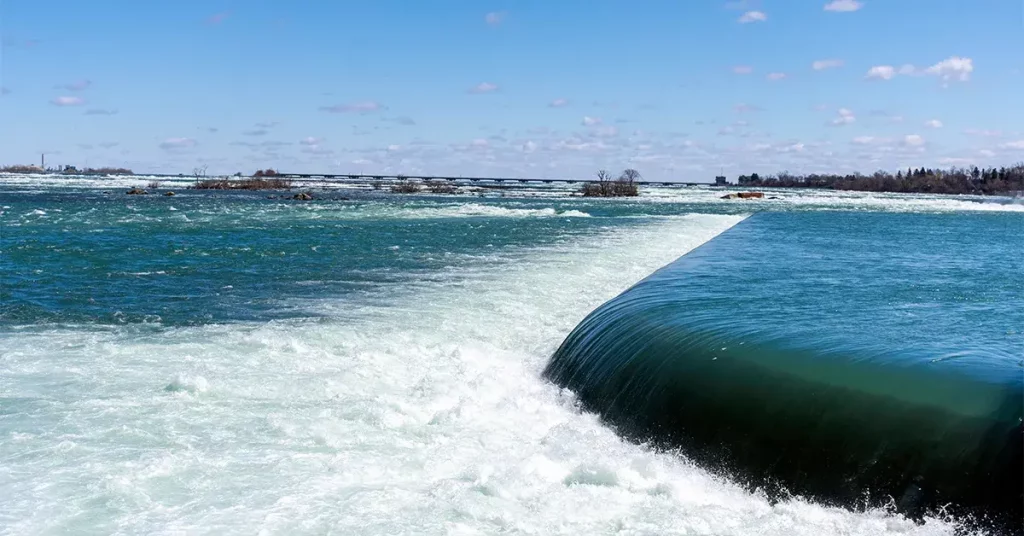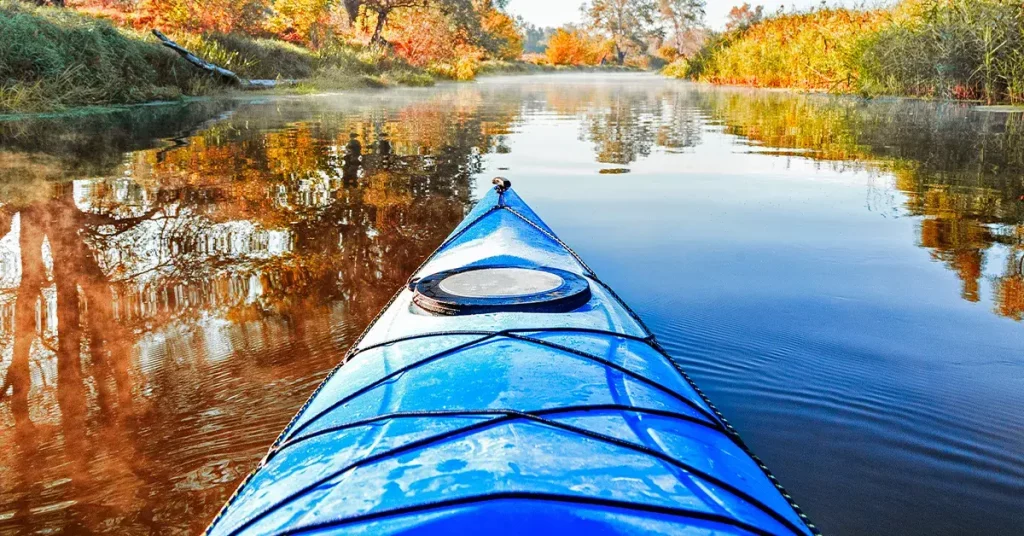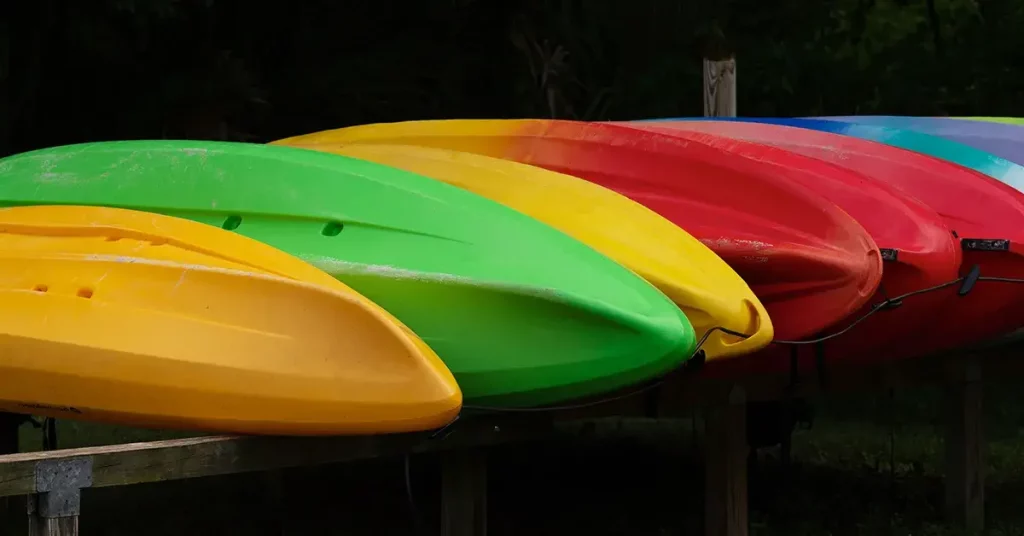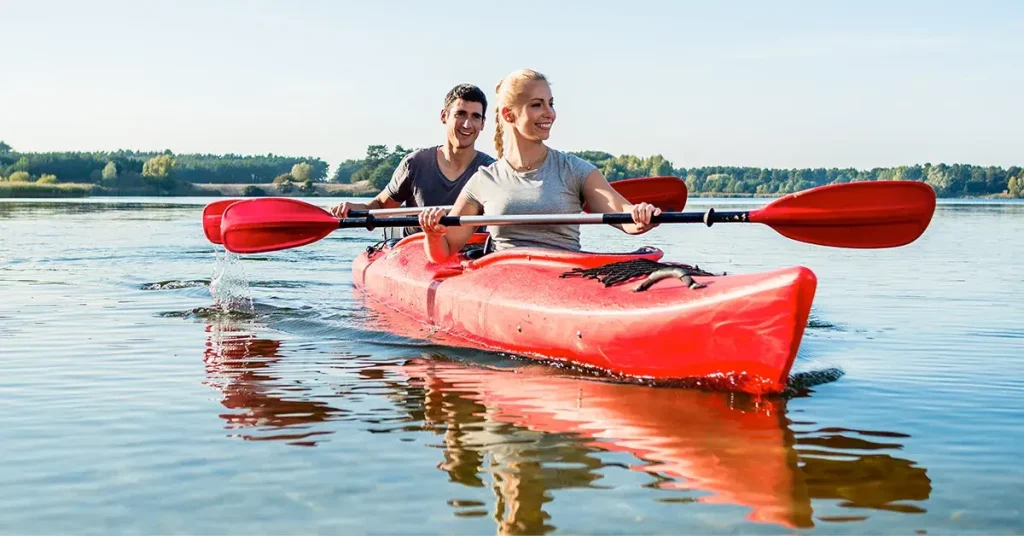Kayaking involves several risks, like approaching low-head dams. Knowing what they look like can help you stay safe while kayaking. If you wonder what should you do when approaching a low-head dam in a kayak, the quick answer is to avoid it.
What is a Low-Head Dam?

Low-head dams are low-profile concrete walls that span the width of a river. These submerged barriers are level with the river, giving them the “low-head” name. They partially close the river to raise it on one side. The river water crosses over the barrier to reach the lower level. Sometimes, the dams have calm water at the approach. They can also be silent, so paddlers don’t see or hear them. The barriers are also called weirs. The water flows freely over them, making the current at the bottom deadly. It’s almost like a small waterfall, where the cascade of water swirls around in the backwash current at the base.
Why Do Low-Head Dams Exist?

The aged weirs exist all over the United States as companies built them to power mills and factories. They help with water irrigation and community water supplies, but they have become deadly for paddlers who enjoy recreational kayaking.
Engineers built these artificial structures in the 1800s and early 1900s. They regulate water flow, and most paddlers find them in rural and urban streams and rivers. Paddlers estimate at least 3,000 low-head dams around the country, and very few are labeled a warning sign. Some low-head dams are natural structures in local waterways where the ground below the river drops. Regardless of the dam origins, they have continuous water pooling with other debris at the bottom.
Why Are Low-Head Dams Dangerous?

Low-head dams don’t look as frightening as a full-size dam and spillway gates, but they are.
Kayakers avoid full-size dams with ease because kayakers can see them. Unfortunately, low-head dams hide below the surface. Since kayakers sit atop the river surface, they cannot see the low-head dams until they are on them. The surprise factor is part of the danger. Another danger for kayakers at low-head dams involves the lack of markings and warning signs. Their strong currents put kayakers in physical danger, as most do not have the strength to paddle to the nearest bank to avoid the danger zones and encounter high hydraulic forces.
Once kayakers find themselves near the problem, they get sucked into the turbulent water flow and pushed underwater repeatedly. If they cross the wall, the power of the water pulls the kayaker into the recirculating current, where you become a victim of the hydraulic force by becoming fully submerged. You could get trapped in the hazardous underwater current without a means of escape. The additional danger comes from the debris trapped in and above the dam. Debris can include branches and solid material that can cut or impale you while trying to escape the terrible strength of the dam.
The Danger of the Boil

You could also become trapped in the boil – the recirculating current that pulls you under the water and traps you against the underwater wall. Whether in a canoe or kayak, you cannot fight this water pressure, as it involves a constant hydraulic force.
The blockages don’t have to be deep to be drowning machines, as the problem involves continuously turbulent waters. However, the currents become a seriously dangerous situation after heavy rain, as the increased flow can make the current stronger. Higher water levels make the backwash extend farther past the base of the weir.
Do Life Jackets Help?

Kayakers should always wear life jackets, but personal floatation devices are useless against the boil of a low-head dam. The pressure of the intense water flow, circulating current, and disturbed water makes your personal flotation device useless in forceful turbulence.
Sadly, rescue teams cannot do much to save kayakers trapped in the turbulent flow of the drowning machine. The best thing to do when approaching a low-head dam is to get away as quickly as possible before you get trapped in the flow that pulls you into the washing machine-like current.
How to Avoid a Low-Head Dam

Before you set off on your kayak trip, learn about the route. Check the latest detailed waterway maps to look for low-head dams and other potential blockages along the way. If your maps don’t include low-head dams, check with your local paddling clubs for better information.
If a route has an upcoming dam, pick a new route. Only three states have laws that require markings of low-head dams ahead. Many low-head weirs exist near old factories or mills. You might see markings of ruins on your map.Warning signs might be the ruins of the factory. If they still exist, you should portage and walk around the danger of the low head dam ahead.
How Can You Tell If You Are Near a Low-Head Dam?

Other than a marked sign, kayakers have two ways to determine if they are nearing a low-head dam. The first is seeing one, which is very difficult. The second is noticing the current, as paddlers find it difficult to steer as currents become powerful. If you find that you cannot steer, immediately turn away from the dangerous situation as a precautionary measure. No one in a canoe or kayak should ever try to cross one. Your safety depends on staying as far away as you can.
What is the Safest Way to Cross a Low-Head Dam?

When your route involves having to cross a low-head dam, the only way you should do it is by getting out of the water and bringing your kayak with you. Kayak to the shore, take your kayak out of the water, and carry it around the base of the dam. Ideally, you should get at least 100 feet away from the dam to be completely safe.
Conclusion
So, what should you do when approaching a low-head dam in a kayak? The safest way to cross a low-head dam is to avoid it altogether. Study your route before you begin paddling. Learn about the signs of weirs so you avoid them before you get sucked into them.




